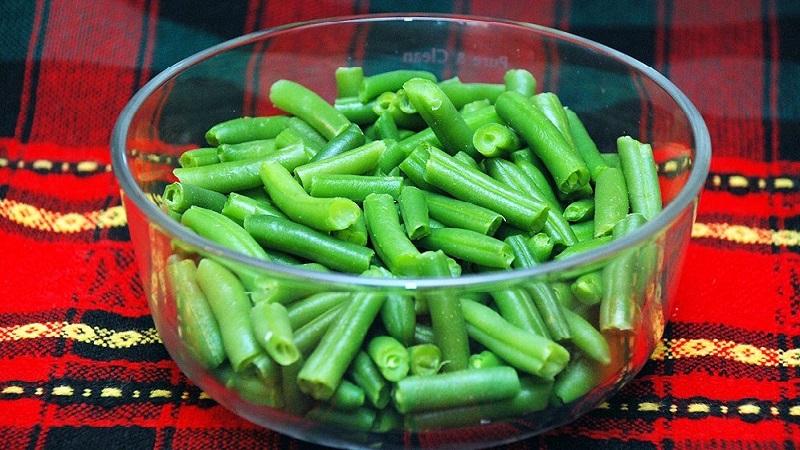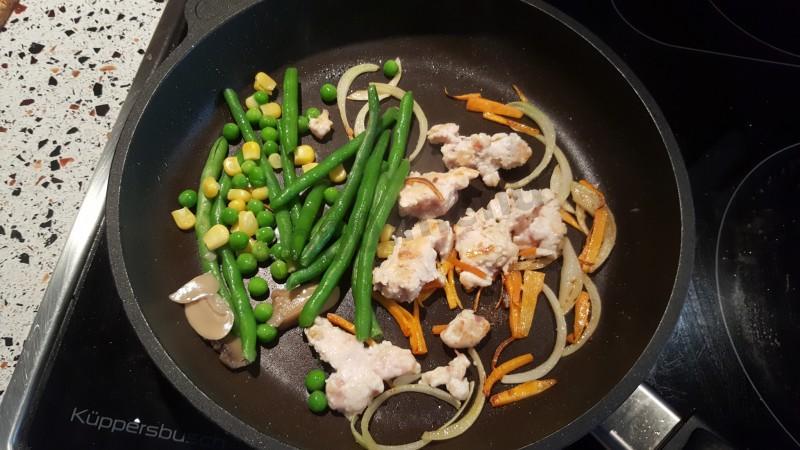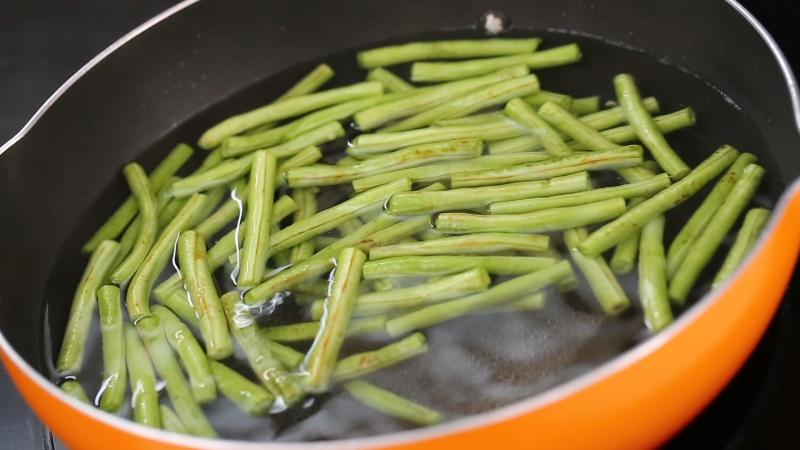Why green beans are good: benefits and harms, a list of contraindications and various ways to use them
String beans in our country are better known as asparagus. It got this name because the vegetable resembles asparagus in taste and appearance. However, the nutritional and vitamin composition of beans is much richer.
This legume is used in both cooking, and in folk medicine and even cosmetology. Consider what benefits green beans can bring and how to eat them correctly so as not to harm your health.
The content of the article
- The composition of the product
- The benefits and harms of green beans
- Frozen product
- Vegetable in the diet of pregnant women and children
- Green beans in dietary nutrition
- Recommendations of cosmetologists
- Traditional medicine recipes
- Cooking Uses and Recipes
- How to prepare asparagus beans for the winter
- Conclusion
The composition of the product
Asparagus beans are a healthy vegetable rich in minerals, vitamins and other organic compounds.
Nutritional value of the product (per 100 g):
- proteins - 2.5 g;
- carbohydrates - 3 g;
- water - 90 g;
- fats - 0.3 g;
- fiber - 3.4 g
The calorie content of green beans is 23 kcal per 100 g.
Pods and seeds contain many beneficial elements and compounds. So, beans include:
- vitamin C;
- carotene;
- folic acid;
- a nicotinic acid;
- tocopherol;
- proteins;
- cellulose;
- vitamins A and E;
- fats;
- carbohydrates;
- minerals (zinc, copper, chromium, iron, sulfur, potassium, calcium, magnesium).

The benefits and harms of green beans
With regular use of green beans in food, the unique composition of the product contributes to:
- reduce the risk of heart attack and strengthen the immune system;
- normalization of the menstrual cycle and hormonal levels in women;
- improving the functioning of the genitourinary system in men;
- prevention of prostate adenoma;
- skin toning, anti-aging effect;
- stopping hair loss and hair restoration;
- cleansing the body of toxins;
- replenishment of calcium deficiency;
- getting rid of sand in the kidneys.
In addition, this vegetable helps to cope with nervous disorders and stress.
With gastritis, gastric ulcer and duodenal ulcer, gout, cholecystitis, it is recommended to exclude it from the diet. Caution is advised to use the product in food for people prone to constipation.
Raw pods contain phenazine, a poisonous substance. It can lead to severe poisoning and damage the lining of the stomach and intestines. Therefore, asparagus beans are always initially heat-treated and only then they start cooking.
Important! The primary cooking time should be at least half an hour in order to destroy all harmful substances.

Frozen product
Asparagus beans tolerate freezing well. The benefits of the product do not change: almost all vitamins, minerals and fiber are preserved. The main condition for the preservation of useful properties is the absence of repeated freezing. The recommendations for use remain the same as for freshly harvested pods.
Freezing is the easiest way to prepare beans for the winter. Boiled pods need to be cooled, packaged in bags or containers and placed in the freezer.
Important!Freeze beans in small portions for one application. Avoid re-freezing: it destroys vitamins and nutrients.
Vegetable in the diet of pregnant women and children
During pregnancy, women adjust their menu, trying to select products with the greatest benefit for the unborn baby. Black Eyed Peas - an excellent source of folic acid, iron and B vitamins. These nutrients support the full development of the fetus.
Children at the age of 7-8 months, along with other vegetables, are introduced into complementary foods and green bean pods. They are added in small quantities to soups and purees from other vegetables, to which the baby is not allergic. Begin to introduce into the diet with half a teaspoon.
Green beans in dietary nutrition
What are the benefits of asparagus beans for weight loss? Firstly, it is a low-calorie product, which allows it to be the basis of a variety of diets. Secondly, the vegetable contains phaseolamine, a plant extract that blocks enzymes that break down carbohydrates.
As a result, glucose and other sugars do not enter the bloodstream. The body is deprived of its main source of energy, without which its vital activity is impossible. Glycogen stores from the liver and muscles are used. The next source of energy is subcutaneous fat. Thus, by regularly eating green beans, a person loses weight.
Important!Green vegetable is included in diets for diabetics due to its arginine content. This substance helps lower blood sugar levels like insulin.
Recommendations of cosmetologists
Legumes are used in cosmetology to maintain health and fresh skin and hair.
Rinsing with a decoction of the pods makes the hair strong and silky, stimulates its growth and gets rid of dandruff.
For people with sensitive and dry skin, beauticians recommend making masks made from fresh asparagus beans that are easy to make. Grind 50 g of pods into a gruel, add 15 ml of vegetable oil and grapefruit juice, mix. Apply to skin for 15 minutes. After the procedure, wash your face with warm water.
Traditional medicine recipes
With drug therapy for many diseases, in order to obtain a greater effect, it is recommended to combine the use of drugs with folk remedies. Asparagus beans are a good aid in treating diabetes. Let's consider how to take it correctly.
Pod decoction
Place 50 bean pods in 2 liters of hot water. Soak in a water bath for three hours, strain. Drink the broth four times a day, 200 ml before meals. The course of application is three months.
Asparagus bean tea
Pour 15 g of chopped pods with a glass of boiling water, cook over low heat for 10-15 minutes. Let the tea brew and cool, strain it. Take two tablespoons three times daily before meals.
The decoction and tea from green beans help maintain blood sugar levels at the desired level for several hours.
Important!When using folk recipes, do not forget to follow the diet prescribed by your doctor.
Cooking Uses and Recipes
The vegetable is popular in cooking: it is added to casseroles, salads, stews, soups and omelets. We present to you some interesting recipes based on green beans.
Stewed beans with chicken
Delicious and very easy to prepare dish.
Ingredients:
- chicken breast - 2 pcs.;
- carrots - 1 pc.;
- onions - 1 pc .;
- garlic - 1 clove;
- Bulgarian pepper - 1 PC.;
- green beans - 0.5 kg;
- salt, spices, dill, parsley - to taste.
Preparation:
- Cut the chicken breast and fry in a pan.
- Add half rings of onion, grated carrots, spices and salt to taste to the seared chicken pieces.
- Cut the peppers and garlic into strips and add vegetables to the skillet.
- Place the boiled beans in a frying pan, cover and simmer for 10-15 minutes over low heat.
- Before turning off the burner, pour the finely chopped herbs into the cooking dish, stir, cover and let it brew for a few minutes.
Serve hot. A creamy garlic dressing works well with this dish.

Bean ragout with mushrooms
Legumes in dishes go well not only with vegetables and meat, but also with mushrooms.
Ingredients:
- champignons - 350 g;
- frozen or fresh green beans - 400 g;
- onion - 1 pc.;
- garlic - 3 cloves;
- ground black pepper and salt to taste.
Preparation:
- Cut the mushrooms into thin slices, cut the onion into half rings, chop the garlic.
- While you are busy slicing vegetables, boil the pods. At the end of cooking, discard them in a colander to get rid of excess water.
- In a hot skillet in vegetable oil, fry the garlic and onion until golden brown.
- Add mushrooms. Do not cover the pan so that all the liquid has evaporated.
- Add the beans.
- Stir well and simmer over low heat for 10 minutes.
Stewed beans with vegetables
In Korean, Greek, Italian cuisine, there are vegetable dishes based on asparagus beans. They differ in the way they are prepared and in the set of ingredients.
We offer you a recipe for Greek beans.
Ingredients:
- asparagus beans - 200 g;
- carrots - 1 pc.;
- potatoes - 3 pcs.;
- tomato - 4 things.;
- garlic - 3 cloves;
- onions - 2 pcs.;
- tomato paste - 400 ml;
- dill and parsley - in a bunch;
- sugar, pepper, salt.
Preparation:
- Cut the tails off washed and boiled pods.
- Cut the beans into 3-4 cm pieces, the potatoes into strips, the tomatoes into thin slices.
- Put onion, cut into half rings, in a hot frying pan with vegetable oil.
- Once the onion is golden, add the finely chopped garlic.
- After three minutes, you can add potatoes, onions and carrots.
- Fry the vegetables over medium heat, add tomatoes, tomato paste, parsley and a pinch of sugar.
- Cover the pan with a lid and simmer over low heat for an hour.
- 10 minutes before cooking, sprinkle the stew with spices, dill and salt.
The dish is served hot, garnished with grated cheese and nuts.

How to prepare asparagus beans for the winter
The simplest method - freezing - we have already covered. A more laborious way of harvesting is canning.
Ingredients:
- asparagus beans - 3 kg;
- 9% vinegar - 50 g;
- salt - 1 tbsp. l .;
- sugar - 100 g;
- water - 1 l.
Important! For marinating, choose pods that are not overripe and dense without damage.
Preparation:
- Rinse the beans under running water, trim the tails.
- Cut into small pieces, cover with water.
- Put the pot on fire for 5-10 minutes and drain in a colander.
- Arrange the pods in sterile jars and cover with boiling water. Let it brew for half an hour.
- Drain the water into a saucepan and bring to a boil again.
- Add sugar, vinegar, salt.
- Pour the resulting marinade into jars and roll them up with lids.
- Place the jars on the lids and cover with a warm blanket. Leave in this state until it cools completely.
Pickled beans are served as a salad with chopped nuts and garlic. You can season it with mayonnaise or vegetable oil.

Conclusion
Asparagus beans are a storehouse of vitamins and nutrients. When consumed regularly, it can help you lose weight. The legumes can be grown in the garden and stored until spring in the form of freezing or canned food, providing themselves with vitamins for the whole winter.
This vegetable can form the basis of many delicious and healthy dishes, as well as serve as a cosmetic and health remedy for traditional medicine.